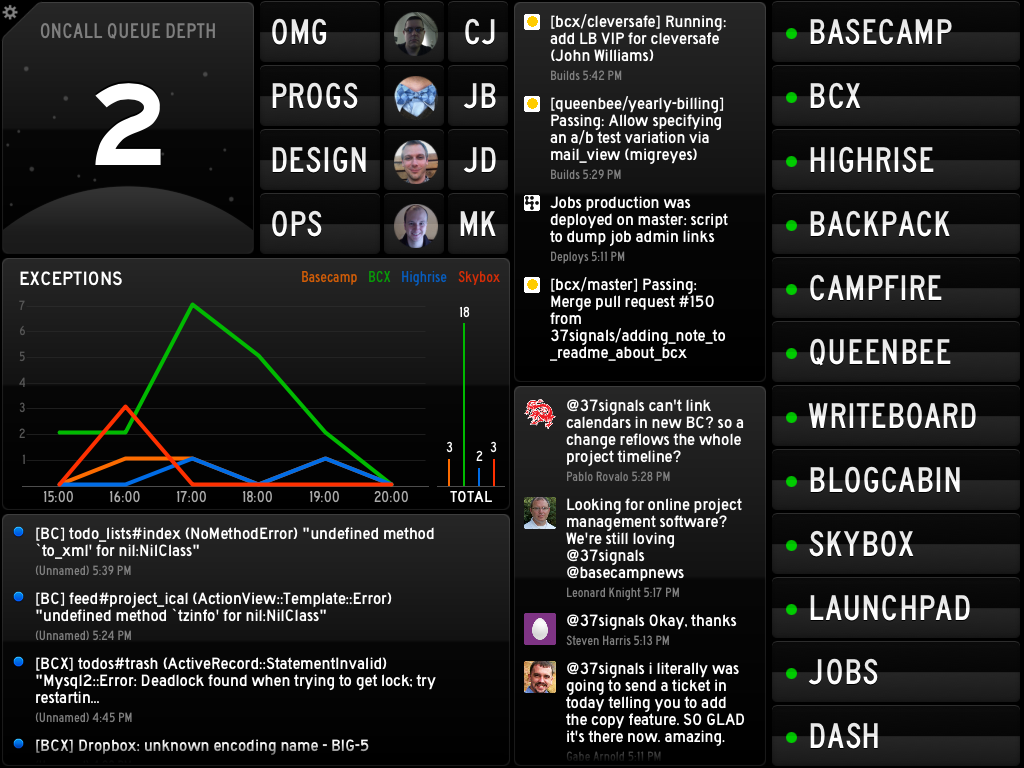We have a lot of data to parse through at 37signals. Our internal stats application, Dash, does the majority of heavy data lifting for us, including reports, application health, CI builds, and much more. Our Campfire bot named Tally happily pings us when a build fails, deploys are fired off, and when Nagios alerts pop up.
I had a problem though: I needed to have all of this data open constantly to absorb it. Either I had to look at the pages on Dash directly or make sure I’m in the reading through messages in the right Campfire room.
I decided it was time to fix this overload. The release of Status Board let me take a step back and understand what pieces of data really mattered to my daily work. As a programmer, I want to answer a few questions:
- What’s the on-call load like? Do I need to help out?
- Are there are any problems with our apps?
- Is there an influx of exceptions?
- What are other developers up to?
My iPad Mini now answers these questions for me. I just set it up next to my laptop and keep it on when working. Instead of swapping tabs over to Reddit or Hacker News to get distracted, I’ve been trying to use my Mini as a focus point instead.
Here’s what my board looks like, and what data it contains:

- How many unanswered tickets our on-call queue holds
- Who’s responsible for on-call right now across the company
- A graph of exceptions across all apps over the past 6 hours
- Latest exceptions directly from our monitoring inbox
- RSS feeds of latest deploys and builds kicked off
- Mentions of @37signals and basecamp.com on Twitter
- Green/red status for each app based on Nagios alerts
That’s a lot of data densely packed into one iPad screen! Integrating with Status Board really didn’t take that much effort. For a table, serve up an HTML table. For graph data, wire up some JSON. Need more than that? Drop in an entire HTML page if you need it. There’s guides for hooking up your data included, and I was able to test changes locally using xip.io.
I’ve focused my board to just data I personally need to react to. Exceptions are high? Let’s find out why. The queue looks deep? Pitch in and close a ticket or two. Why is that app’s status red? Dive into the alert and see what’s up.
The best part about it though: I can just open up my iPad and find out the answers to my questions, immediately.
Thanks to Jeremy once again for feedback!

Kris G.
on 26 Apr 13Would love to know what Skybox is…
Nick
on 26 Apr 13Skybox is one of our internal apps. It helps manage our suites across different apps.
Joe
on 26 Apr 13Nice. I like it. Why monitoring for mentions of basecamp.com but not highrisehq.com, campfirenow.com, etc?
Lee
on 26 Apr 13Is this a native iOS app, a website, on one of those hybrid apps you’ve spoken so highly of before?
Nick
on 26 Apr 13Joe: No reason, I’m still playing with the usefulness of the twitter feed at all on my board.
Lee: It’s a native iPad app: http://panic.com/statusboard/
Jacob
on 26 Apr 13These kind of Dash boards just give people hard-ons but provide little in actual value.
Yes, they look “kool”, and it’s also why big corporate executives spend big money on such dashboards but really … other than it looking pretty, does it really provide you with valuable insight that you’d look at often?
I’d say not.
The fundamental issue with all dashboards is it’s simply a monitoring system and doesn’t provide action. Meaning, you only get value from it when you are actually LOOKING at it and even then, the value is “oh, nice – everything is green” ... at which point, after a few times of you launching the Dashboard app and seeing all green indicators, you begin to stop using the app.
What a good Dashboard really needs is ALERTING. So, it detects a services is down, it either tries to fix the issue and/or sends you an alert to address it. With this kind of system, you don’t need a UI. Which is why Nagios (et al.) have worked well for some many years.
Mark W
on 26 Apr 13+1 Jacob
I too have never understood people obsession with dashboards other than I’m convinced it’s an ego thing.
What Jacob says about things being all green and then never going back to using the app .. That’s exactly why I never go to status.37signals.com anymore.
Jason Green
on 26 Apr 13I just built my first CI server yesterday using these instructions and it’s been great to get it automated. But now this post has just filled my day with more setup. Status Board looks like an awesome way to keep an eye on it. Thanks Nick.
D. Lambert
on 26 Apr 13Very interesting. I saw the basic instructions for the DIY displays, but I didn’t see anything in there about an ability to authenticate a user. Is there any provision for this, or am I limited to displaying only information that I’m willing to make accessible via a public web server?
Nick
on 26 Apr 13D. Lambert: It supports basic authentication for custom data sources as of the latest version, so that’s what I’m using.
Joe
on 26 Apr 13It’s so funny when people do this.
Nick: “I find this useful and see value in it”.
Jacob: “No, you don’t.”
We’re strange creatures.
Daman
on 26 Apr 13+1 Joe: YES!
Nice post, it’s cool to see some customization of the app being done. I’m on the hopeful side that Panic will release an OS X version, would make perfect sense for secondary/tertiary displays, or heads up in a common area on a large screen.
D. Lambert
on 29 Apr 13Thanks, Nick—perfect!
Magnus
on 02 May 13Is there a reason you use a whole column to show systems that are up? Wouldn’t it be enough to show those that aren’t? A lot of screen real estate there…
This discussion is closed.